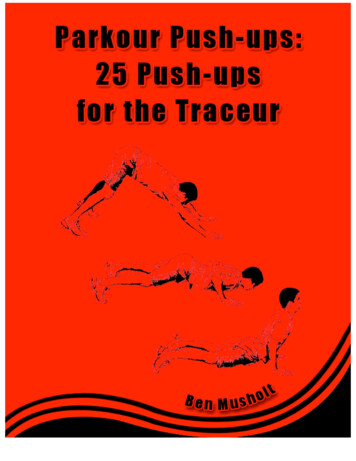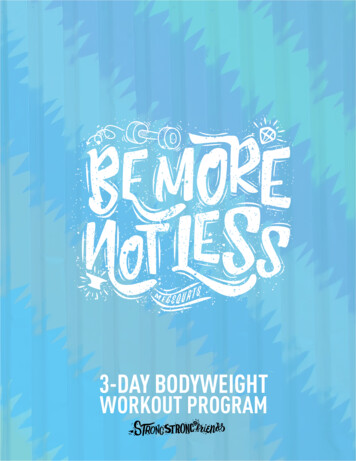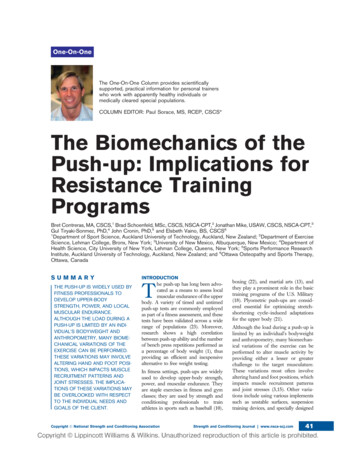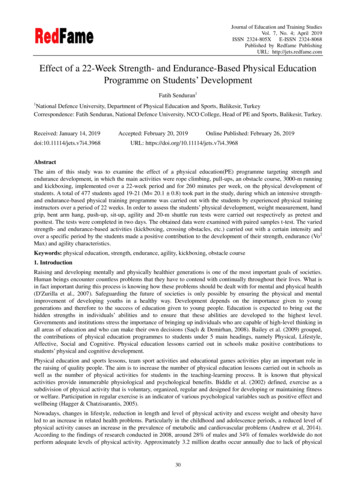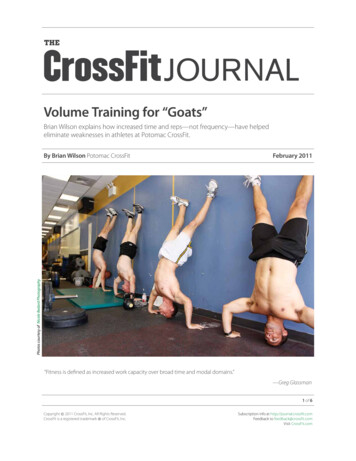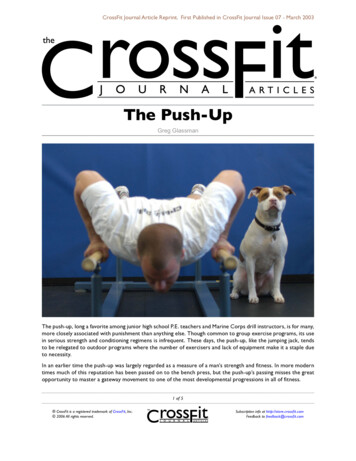
Transcription
CrossFit Journal Article Reprint. First Published in CrossFit Journal Issue 07 - March 2003The Push-UpGreg GlassmanThe push-up, long a favorite among junior high school P.E. teachers and Marine Corps drill instructors, is for many,more closely associated with punishment than anything else. Though common to group exercise programs, its usein serious strength and conditioning regimens is infrequent. These days, the push-up, like the jumping jack, tendsto be relegated to outdoor programs where the number of exercisers and lack of equipment make it a staple dueto necessity.In an earlier time the push-up was largely regarded as a measure of a man’s strength and fitness. In more moderntimes much of this reputation has been passed on to the bench press, but the push-up’s passing misses the greatopportunity to master a gateway movement to one of the most developmental progressions in all of fitness. of 5 CrossFit is a registered trademark of CrossFit, Inc. 2006 All rights reserved.Subscription info at http://store.crossfit.comFeedback to feedback@crossfit.com
The Push-Up (continued.)The push-up is more a family of movements than a singleexercise. In fact, it is a progression that starts from thehorizontal, which is the classic “P.E. push-up” and then,through gradually, incrementally, elevating the feet fromthe floor to a point where the athlete is eventually in ahandstand, becomes the handstand push-up.The handstand push-up, at the far end of the progression,is a challenging exercise that, when freed from the wall,becomes an extraordinary feat of strength and balancethat has no peer in weightlifting movements. At themoment of performing twenty handstand push-upswithout benefit of the wall, the athlete has achieved alevel of strength and balance that not one in a hundredthousand gym goers will ever realize. The integration ofstrength and balance gives the handstand push-up, eventhough limited to bodyweight, an athletic edge thatbrings this movement to at least peer status with eventhe heaviest of presses – whether bench, overhead,or jerk. Twenty handstand push-ups in the middle ofthe room or on parallel bars, again without the wall,confers, automatically, a single-rep military press ofperhaps 150% bodyweight, whereas a 150% bodyweightsingle-rep military press suggests little or nothing aboutan athlete’s balance.The possibilities and potentials don’t end at twenty,thirty, or even fifty handstand push-ups. Considerfor just a moment the hand, finger, and grip strengthdeveloped through performing these handstand pushups on fingertips – at first all five fingers, then four,and eventually three. Then there are the presses tothe handstand that will come smoothly, easily, andconfidently as a bonus to the handstand push-up, butwe’re getting years ahead of ourselves here.Mastery of the basic, entry-level “P.E. push-up” is aprerequisite to the handstand push-up. Very few peoplehave achieved mastery of the push-up though many ofyou think you have. The test is simple: can you do 100perfect push-ups? The standard for perfection, thoughsimple, disqualifies nearly everyone. A perfect push-up isslow and deep with a body absolutely perfectly straightand taut. We’ve listed the most common push-up faultsbelow. Not one in fifty guys with a 300-pound benchpress can do 50 honest push-ups!So, “what is an honest push-up?” An honest push-upmoves slowly from full extension to a point of maximumdepth without “reaching” for the ground or perturbingthe body’s taut, rigid, straight-line posture, and thenreturns rigidly to full extension. Done correctly, thepush-up is a super demanding whole-body movement.Engage as many stabilizers as possible.An honest push-up of 5 CrossFit is a registered trademark of CrossFit, Inc. 2006 All rights reserved.Subscription info at http://store.crossfit.comFeedback to feedback@crossfit.com
The Push-Up (continued.)“Reaching for the ground” is trying to find the bottom of thestroke early. The two most common “reaching” cheats aredone by craning the neck to find the ground with the noseearly or dropping the belly to find bottom early. The ideal isto retard, not advance, the body’s parts from finding bottom– nose, chest, belly, thighs, and pelvis are each in a race tosee which can reach bottom last, not first.“Perturbing the body’s taut, rigid, straight-line posture” isevident when the butt sticks up or the belly sags toward thefloor. By our standards a drop of the middle (belly sagging)or lifting of the butt in the air terminates the set. So doesstopping and resting at any point. The standard is tough– super-taut straight body, full range of motion (without“reaching”), and resting only when finished.We do our push-ups on the floor, parallettes, and parallelbars, but the parallel bars or parallettes are better than thefloor because they allow for another six inches of travel.If performing push-ups on the floor we start our athletesfrom flat on the floor with the nose, chest, pelvis, and thighs– as much of the body as possible – making contact and thenbegin. The posture on the floor sets the posture for theentire set.Progressing from the basic push-up to the handstand pushup is a simple matter of elevating the feet in small incrementsover time. A chair, plyo box, or securely racked bar all makegood platforms for elevating the feet.At first your handstand push-ups will require kicking yourheels and posterior against the wall for balance. If you areperforming this on the floor, you may want to place a small,flat pillow on the ground, under your head, and lower yourselfslowly until the top of your head touches, and then pressback up. When you can do half a dozen or so confidently,remove the pillow and the contact point becomes the nose,not the top of the head.The handstand push-up is very similar in feel and difficultyon the parallettes and on the floor, but on the parallel barsthe possible range of depth is several inches lower andconsequently much harder.In future issues we are going to detail the most commonpresses to a handstand. You’ll want to get the upper hand onthese presses by improving your push-ups first.Greg is half way to the handstand push-up of 5 CrossFit is a registered trademark of CrossFit, Inc. 2006 All rights reserved.Subscription info at http://store.crossfit.comFeedback to feedback@crossfit.com
The Push-Up (continued.)10 Push-up Milestones andChallengesHere is a progression that should keep anyone busyfor a couple of years.1.2.3.4.5.Fifty honest basic push-upsTen handstand push-ups100 honest basic push-upsFifteen handstand push-upsTabata interval basic push-ups with 20 reps ineach of 8 intervals6. One handstand push-up without use of wall7. Ten handstand push-ups without use of wall8. Fifteen handstand push-ups without use ofwall9. Twenty handstand push-ups without use ofwall10. One handstand push-up without use of walland on fingertipsPush-up Links1. Push-up records: 2. Charles Linster was an early world record holderwith an inspirational story of courage and ulysses.html 9697/ulysses yield.html.3. Here is the ultimate guide to parallettes and anexcellent source for some of the coolest parallettes ever.Learn these skills and your fitness will skyrocket! http://www.american-gymnast.com/technically correct/paralletteguide/titlepage.html.4. Or, you can make your own parallettes. This isone of our favorite sites on the Internet: http://www.drillsandskills.com/skills/cond. At the end of this listof some beautiful skills and drills are instructions forbuilding a perfectly suitable set of parallettes forpractically nothing:A Cheater’s Guide to Lousy Push-upsAvoid each of these and you are nearly guaranteed an honest push-up.1.Sagging: Dropping the belly in an attempt to hit, or reach bottom early2.Piking: Sticking the butt up in the air. This is usually accompanying a rest(see resting, below).3.Resting: Coming to a stop. This is usually tried at the top, often whilepiking, but may manifest as a collapse at the bottom.4.Bouncing: This cheat is, exactly as the name implies, bouncing off thefloor to rise to top again without effort. This is a big hit with fat guys.5.Yogaing: With this cheat, the head and neck lead up followed by thechest then belly. It is a dynamic variant of sagging, but often performed asthough it were a plus or artistic.6.Reaching: Reaching’s most common form is with the head and neck. Somecheaters can extend their head and neck an extra six inches in an attemptto find bottom early and avoid the pain of a real push-up. Look for thenose a foot below the chest.7.Speeding: The count should be a slow “one-two” up and “one-two” downunless doing timed efforts like the Tabata Interval. For reps, they have tobe slow and controlled.8.Shorting: This is the worst and most common cheat where the cheatertypically doesn’t go all the way down. Not rising to the top is less commonbut still cheating. of 5 CrossFit is a registered trademark of CrossFit, Inc. 2006 All rights reserved.Subscription info at http://store.crossfit.comFeedback to feedback@crossfit.com
The Push-Up (continued.)Greg Glassman is the founder (with LaurenGlassman) of CrossFit, Inc. and CrossFit SantaCruz and is the publisher of the CrossFit Journal. of 5 CrossFit is a registered trademark of CrossFit, Inc. 2006 All rights reserved.Subscription info at http://store.crossfit.comFeedback to feedback@crossfit.com
perfect push-ups? The standard for perfection, though simple, disqualifies nearly everyone. A perfect push-up is slow and deep with a body absolutely perfectly straight and taut. We’ve listed the most common push-up faults below. Not one in fifty guys with a 300-pound bench press can do 50 honest push-ups! So, “what is an honest push-up?”

